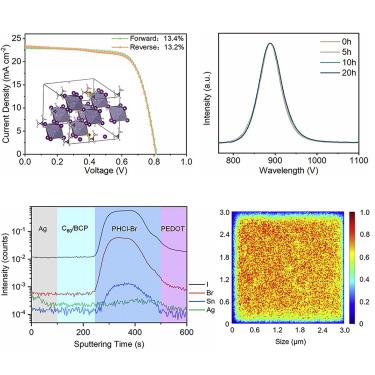Matter ( IF 17.3 ) Pub Date : 2020-12-10 , DOI: 10.1016/j.matt.2020.11.012
Chengbo Wang , Yuting Zhang , Feidan Gu , Ziran Zhao , Haisheng Li , Hong Jiang , Zuqiang Bian , Zhiwei Liu

|
The organic-inorganic hybrid Sn-based perovskite has attracted extensive attention because of its more suitable band gap and environmentally friendly characteristics, but the natural oxidization of Sn2+ makes for unsatisfactory illumination stability and efficiency in solar cells. Here, we successfully proved that the synergistical introduction of phenylhydrazine cation (PhNHNH3+) and halogen anions (Cl– and Br–) could substantially improve the illumination stability of FASnI3 (FA stands for NH2CH = NH2+) through the combination of experiments and theoretical calculations. The resultant device achieved a power conversion efficiency of 13.4% (certified 12.4%) with striking long-term durability; i.e., the optimized device maintained 82% of the original efficiency over 330 h under AM1.5G one-sun illumination. This method provides a universal way for improving the illumination stability and efficiency of Sn-based perovskites.
中文翻译:

苯肼与卤素离子协同控制的照明耐久性和高效锡基钙钛矿太阳能电池
有机-无机杂化Sn基钙钛矿因其更合适的禁带宽度和环境友好特性而受到广泛关注,但是Sn 2+的自然氧化使太阳能电池的照明稳定性和效率无法令人满意。在这里,我们成功地证明了synergistical引入苯肼阳离子的(PhNHNH 3 +)和卤素阴离子(氯-和Br - )可以大大改善FASnI的照明稳定性3(FA代表NH 2 CH = NH 2 +),通过实验和理论计算相结合。最终的器件实现了13.4%(经认证的12.4%)的功率转换效率,并具有出色的长期耐用性;也就是说,经过优化的设备在AM1.5G单日照下在330小时内保持了原始效率的82%。该方法为提高锡基钙钛矿的照明稳定性和效率提供了一种通用的方法。































 京公网安备 11010802027423号
京公网安备 11010802027423号